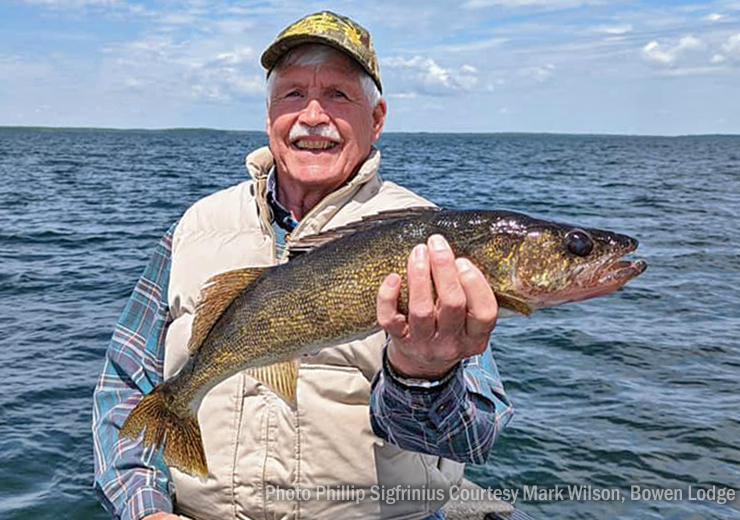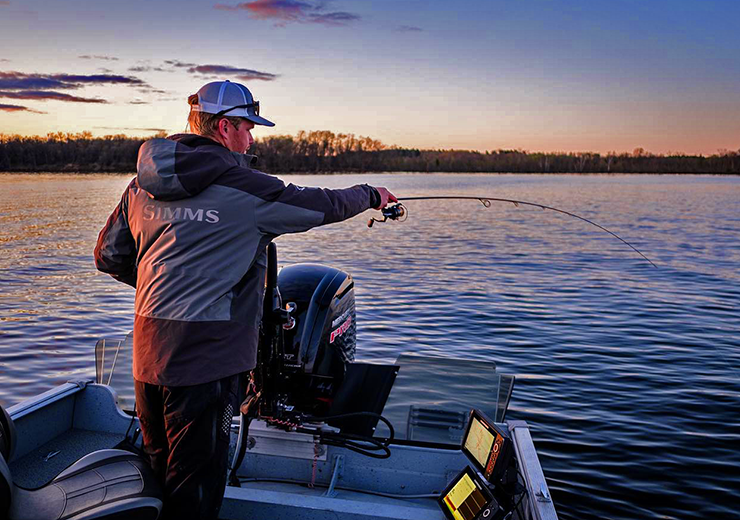Just at the point during mid-summer when you’d think the walleye fishing action SHOULD slow down, IT DOESN’T, at least that’s how it usually works on Lake Winnie!
Image of fishing guide Jared Saufferer (L) with customer and nice walleye double
Warm weather and sunshine have brought water temperatures up. Now in the 76-to-78-degree range, the lake has developed an algae bloom. Algae blooms are good for the lake in many ways, but for anglers, they help by reducing water clarity and that makes it easier to get close to walleyes during the daytime.
Surface water temperatures, in and of themselves are good for anglers too. The rising temperatures increase fish metabolism, encouraging them to feed both more heavily and more often. Trolling patterns, at increased speeds become effective, making it easier for folks to “cover territory”. Anytime you add a bit of wind and some cloud cover, the stage is set for much better daytime fishing.
Mid-summer conditions not only improve the prospects for better walleye fishing. But perch, sunfish, crappie, and bass action has heated up too.
Trolling patterns, particularly trolling with spinners has replaced the jig and minnow as the primary presentation. Moving at 1.1 to 1.4 MPH over shallow rocks, or along the grass lines in 5 to 8 feet of water will produce both walleye and perch on the big lake. Trolling spinners deeper, in water depths of 8 to 12 feet will produce a mixture of walleye, sunfish and crappie when targeting the vegetation in Cutfoot Sioux.
On deeper structure, use bottom bouncers or in-line weights to troll spinners while maintaining depth control. On mid lake structures like bars and humps, key depths are 16 to 22 feet. Over the flats, gravel, and rock stretches in water depths of 12 to 14 feet will produce fish too. When fishing the rocks, jig and minnow presentations will often produce, even during mid-summer, so don’t rule them out either.
Pike, especially large ones should begin moving toward shallow water soon. There are large schools of small fish showing up on the flats in water depths of 12 to 16 feet. As these schools of baitfish grow larger and become more concentrated, pike will find them. Some of the locals set their calendars for both full moon and new moon periods, but don’t be afraid to start experimenting now. Casting large spoons, bucktails and jerkbaits will produce consistently, so will large minnows like suckers, creek chubs and big golden shiners. Live bait can be fished under a slip float very effectively.
Sunfish are finding their way out to deeper vegetation and can be located using the spinners. It might be more efficient though to stop and “still-fish” once you’ve located them. On a recent outing, sunfish were located along the outer edges of a cabbage patch and caught by fishing vertically with a 1/8-ounce jig head, tipped with cut pieces of night crawlers or leeches. Orange, black, and dark green are good color choices for panfish.
Crappies are on the move, but still showing a preference for the early morning and late evening periods. Locating them by trolling spinners is good, but when they’re on the move, casting small jigs tipped with action tails is better. A 1/16-ounce jig tipped with a paddle tail, twister or shad imitation and cast into holes and pockets between cabbage plants is reliable. You’ll be surprised at how many other species of fish may you’ll catch at the same time; they are all susceptible to this presentation.
Yellow Perch are getting easier to find these days and some of them are attractive. Shallow rocks, combined with clam shells and light vegetation are holding them. Scattered packs of perch vary in both number and size structure, with fish ranging from 8 to 12 inches in length. It’s unlikely that you’ll catch limits, but trolling spinners over these shallow structures will produce enough quality size fish to make the pursuit worthwhile.
Bass fishing has heated up with warming water temperatures too. Most reliable locations are in bulrush patches and in dense patches of wild rice. Wacky rigged Senko style worms will produce at sunrise and so will top water baits like slop frogs. Typically, the topwater bite ends early, and by 9:00 AM, you’re better off with submerged presentations. In either type of cover, target the pockets and holes in vegetation using Texas rigged plastic worms or jig-and-pig, jig-and-plastics combinations.














